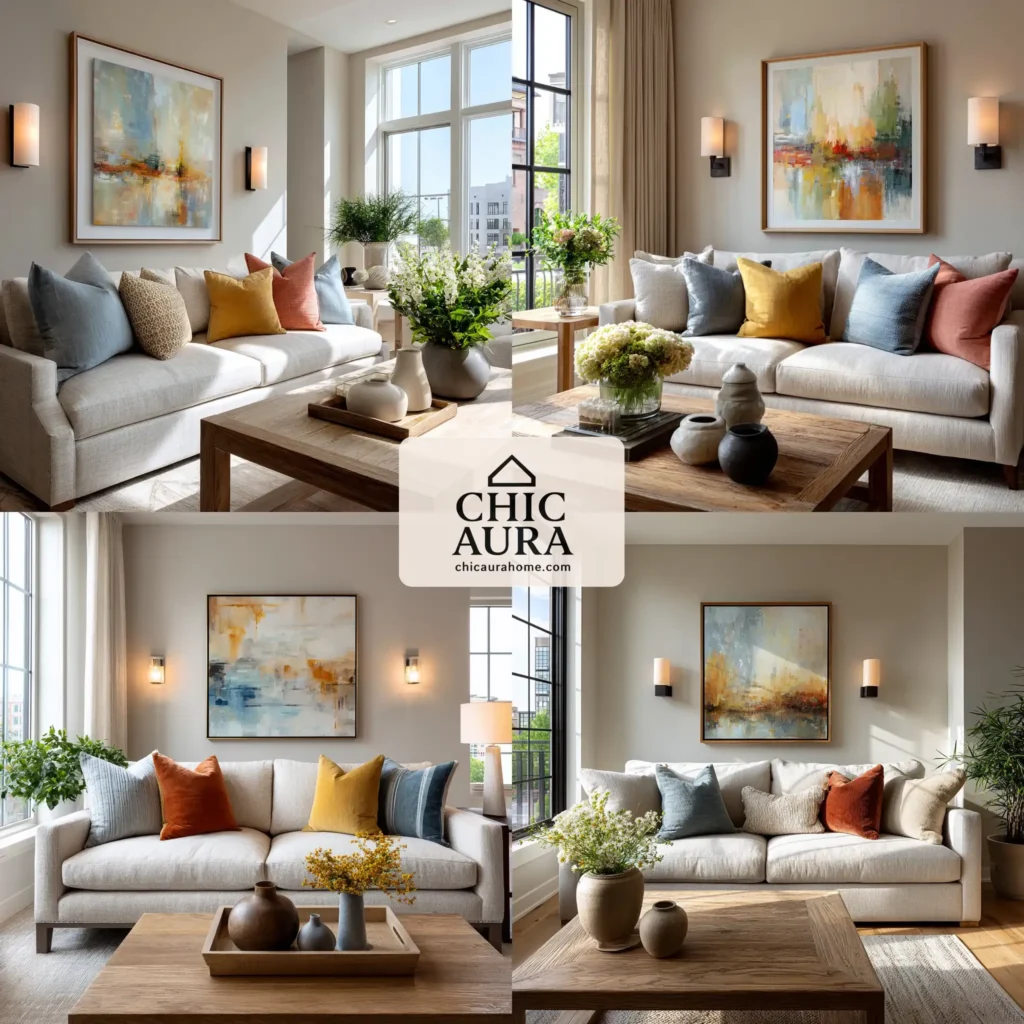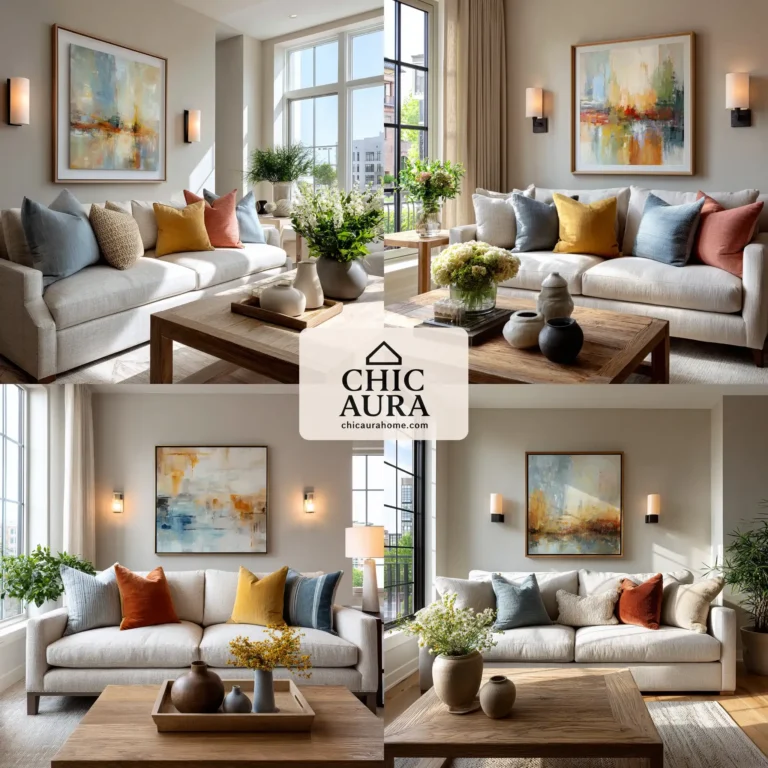Sconces in the living room are a game-changer for creating a warm, inviting, and stylish atmosphere. These versatile lighting fixtures not only illuminate your space but also add a touch of elegance and personality. Whether you’re aiming for a modern, minimalist vibe or a cozy, traditional feel, incorporating sconces into your living room design can transform the space. In this article, we’ll explore seven creative ways to use sconces to enhance your living room, along with tips to make them the focal point of your decor.
What you’ll find in this post:
Why Sconces Are Perfect for Your Living Room
Sconces are wall-mounted lighting fixtures that offer both functionality and aesthetic appeal. They save floor space, provide targeted lighting, and act as decorative elements. By strategically placing sconces in your living room, you can highlight artwork, accentuate architectural features, or create a cozy ambiance for relaxing evenings. With endless styles, from sleek modern designs to ornate vintage-inspired pieces, sconces can complement any interior design theme.
For more inspiration on styling your home, check out our interiors and styling tips.
1. Create a Focal Point with Statement Sconces
Bold, oversized sconces can serve as a stunning focal point in your living room. Choose designs with unique shapes, metallic finishes, or intricate detailing to draw attention. For example, a pair of large, gold-finished sconces on either side of a fireplace or above a console table can add drama and sophistication.
To make the most of statement sconces, ensure they complement your existing decor. If your living room features neutral tones, opt for sconces with warm metallic hues like brass or copper. For a bolder look, choose sconces with geometric patterns or vibrant colors.
2. Highlight Artwork or Mirrors with Sconces
Sconces are perfect for accentuating artwork or mirrors in your living room. Positioning a pair of sconces on either side of a large painting or mirror creates a balanced, gallery-like effect. This setup not only illuminates the artwork but also adds depth and dimension to the space.
When selecting sconces for this purpose, choose slim, understated designs to avoid overpowering the artwork. Adjustable sconces with directional lighting are ideal, as they allow you to focus light exactly where it’s needed.

3. Use Sconces for Task Lighting
If you have a reading nook or a cozy corner in your living room, sconces can provide excellent task lighting. Install adjustable or swing-arm sconces next to your favorite armchair or sofa to create a well-lit spot for reading or working. This setup is both practical and stylish, eliminating the need for bulky floor lamps.
For task lighting, opt for sconces with focused beams or dimmable features. This allows you to adjust the brightness based on your needs, whether you’re reading a book or setting a relaxed mood for movie night.
4. Add Symmetry with Paired Sconces
Symmetry is a timeless design principle that brings balance and harmony to any space. Placing matching sconces on either side of a fireplace, television, or sofa creates a polished and cohesive look. This approach works particularly well in formal or traditional living rooms.
To achieve this look, choose sconces with similar shapes and finishes. For a modern twist, consider asymmetrical sconces with slightly different designs but complementary styles. This adds visual interest while maintaining balance.
5. Incorporate Sconces into a Layered Lighting Scheme
A well-designed living room relies on layered lighting to create depth and ambiance. Sconces play a key role in this approach by providing accent or ambient lighting. Combine sconces with overhead fixtures, such as chandeliers or pendant lights, and floor or table lamps to create a versatile lighting scheme.
For example, use sconces to provide soft, ambient light along the walls, while a chandelier serves as the main light source. This combination allows you to adjust the mood of your living room for different occasions, from lively gatherings to quiet evenings.
For more ideas on creating a cohesive lighting plan, explore this insightful guide on layered lighting.
6. Enhance Architectural Features with Sconces
If your living room has unique architectural elements, such as built-in shelves, alcoves, or exposed brick walls, sconces can highlight these features. Install sconces within or above these areas to draw attention to their texture and design. For instance, a rustic sconce with an Edison bulb can enhance the charm of a brick wall, while sleek, minimalist sconces can accentuate modern built-ins.
When choosing sconces for architectural features, consider the material and style of the element you’re highlighting. A cohesive design ensures the sconces enhance rather than compete with the feature.
7. Experiment with Sconce Placement for Drama
Don’t be afraid to think outside the box when placing sconces in your living room. Instead of traditional placements, such as beside a fireplace or artwork, consider installing sconces in unexpected areas, like above a window or in a corner. This creates a dramatic effect and adds an element of surprise to your design.
For a bold look, try installing a series of sconces along a long wall to create a rhythmic pattern. This works especially well in spacious living rooms where you want to add visual interest without cluttering the space.
Tips for Choosing the Right Sconces for Your Living Room
When selecting sconces for your living room, keep these tips in mind:
- Match the Style: Choose sconces that align with your living room’s overall aesthetic, whether it’s modern, industrial, or traditional.
- Consider Scale: Ensure the size of the sconces is proportionate to the space. Large sconces work well in spacious rooms, while smaller ones suit compact areas.
- Think About Light Output: Decide whether you need bright, task-oriented lighting or soft, ambient light, and choose sconces accordingly.
- Mix Finishes: Don’t be afraid to mix metallic finishes, like brass and matte black, for a modern, eclectic look.
- Check Installation Requirements: Some sconces require hardwiring, while others are plug-in. Ensure your chosen sconces suit your electrical setup.
For additional tips on selecting lighting fixtures, visit our interiors styling category.
FAQs About Using Sconces in the Living Room
Q: How high should sconces be mounted in a living room?
A: Sconces should typically be mounted 60-66 inches from the floor to the center of the fixture, aligning with eye level. Adjust based on your ceiling height and furniture placement.
Q: Can sconces be used as the primary light source in a living room?
A: While sconces are excellent for accent or task lighting, they’re usually not sufficient as the primary light source. Combine them with overhead lighting for a balanced scheme.
Q: Are plug-in sconces a good option for renters?
A: Yes, plug-in sconces are ideal for renters, as they don’t require hardwiring and can be easily installed and removed without damaging walls.
Q: How do I choose the right bulb for my living room sconces?
A: Opt for LED bulbs with a warm color temperature (2700K-3000K) for a cozy ambiance. Choose dimmable bulbs if you want flexibility in lighting intensity.
Conclusion
Sconces in the living room are a versatile and stylish way to elevate your space. From creating a focal point to enhancing architectural features, these fixtures offer endless possibilities for transforming your living room into a warm and inviting haven. By following the seven tips outlined above and choosing sconces that complement your decor, you can achieve a stunning and functional lighting design. Explore more home styling ideas on our interiors and styling page and start reimagining your living room today!

